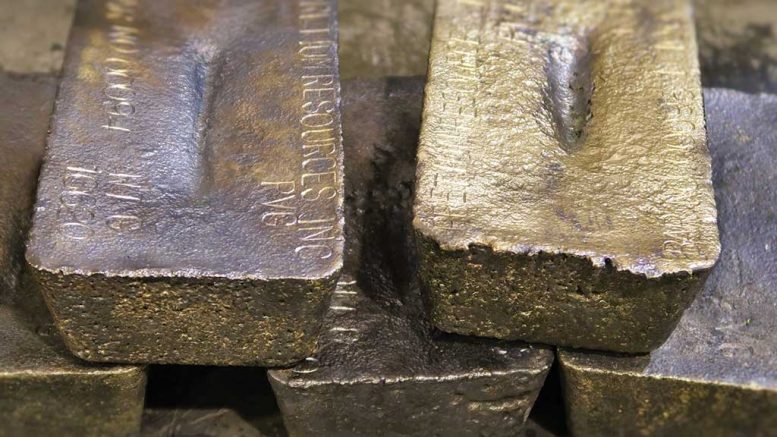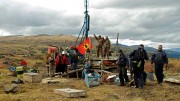Gold investors, miners and explorers have for the most part spent the last few years scoffing at the global cryptocurrency revolution led by Bitcoin and others, with a certain smug confidence that the phenomenon is a bubble prone to a harsh correction at any time.
If it’s all a bubble, the bubble is still growing, and more and more people are taking part: at press time there are 1,324 cryptocurrencies available over the Internet, and the number rises every week, as a new cryptocurrency can be created at any time by anyone.
Bitcoin is now the largest block-chain network by market capitalization at US$194 billion (about the same as the combined market caps of BHP Billiton, Rio Tinto and Glencore), followed by Ethereum, Bitcoin cash, Ripple and Litecoin.
Launched as open-source software in 2009, Bitcoin entered 2017 with a market cap of only $16.4 billion, for an almost twelvefold gain by early December 2017. Many other cryptocurrencies have shown parabolic price charts in the fourth quarter that simultaneously worry chart watchers and excite cryptocurrency’s most fervid advocates.
With U.S. stock markets hitting all-time highs on a near-weekly basis since Donald Trump’s election as U.S. president, it’s starting to feel like the dot-com boom of the late 1990s for the gold crowd, with all the easy profits and market froth happening in the tech capitals of the world, and gold investors left to look for modest gains, at best.

Chart of Bitcoin versus gold prices from 2013 to August 2017. Bitcoin prices surpassed US$12,000 for the first time on Dec. 5, 2017. Credit: Statista.com.
Gold miners’ skepticism comes in part from the cryptocurrency technology’s susceptibility to hacking and covert manipulation, and to a lack of knowledge of the cryptocurrencies — i.e., the perfectly reasonable “I don’t invest in what I don’t understand” approach.
There may also be a generational aspect to the divide, as cryptocurrency proponents are more often younger adults inseparable from their cellphones, which are an ideal tool for carrying out cryptocurrency transactions.
But the stellar price performances over the past couple of months of Bitcoin and other cryptocurrencies combined with the relative flatness of the gold price below US$1,300 per oz. gives the uncanny impression that cryptocurrencies are luring away the next generation of potential gold investors.
Indeed, the personal profile and psychological makeup of the typical cryptocurrency enthusiast and gold bug is virtually identical: male, educated, middle class, independent-minded, anti-tax, distrustful of governments and susceptible to elaborate conspiracy theories on their darkest days.
More traditional precious metal vendors like Kitco and several precious metal newsletters have steered their businesses in recent years to try to serve the crossover cryptocurrency market, with cryptocurrency pricing and commentaries taking increasing page space away from precious metals.
While dozens of moribund precious metal juniors in the late 1990s and mid 2010s changed their businesses to dot-com and medical marijuana models with a resulting pop in share prices, the trend for 2018 among the walking wounded in the gold space may be for more changes in business to serve the cryptocurrency market.
A widely cited example is Tel Aviv-listed Natural Resource Holdings, which has gold and silver properties in North America but announced a few days ago it would buy a 75% stake for $150 million in the Canadian cryptocurrency mining operation Backbone Hosting Solutions, also known as Bitfarms. The mining company’s stock price immediately doubled as a result.

Roy Sebag
Gold bugs will see a familiar name at the centre of the deal: Natural Resource Holdings is led by CEO and founder Roy Sebag, the 32-year-old, Toronto-based contrarian investor who is also CEO and cofounder of GoldMoney Inc., which merged with Sebag’s BitGold in 2015.
Bitfarms operates four farms totalling 25 megawatts and 250 petahash, making it the largest cryptocurrency operator in North America.
Perhaps a bit of good news for Canadian gold mine developers is they have some transferable skills required to build a cryptocurrency farm, and many parts of Canada make for an ideal location for cryptocurrency farms, which need safe, quiet and remote locations, as well as low-cost power and year-round cold weather to cool the furiously active computer banks.
Who knows? In addition to windmills and solar panels, we might someday see the first cryptocurrency farm set up behind high-security mine gates, tucked up against the next gold mine built in some chilly, remote corner of the country.
RELATED STORIES:
Interview: BitGold co-founder Roy Sebag explains company’s philosophy






Be the first to comment on "Editorial: Bitcoin starts to eat gold’s lunch"